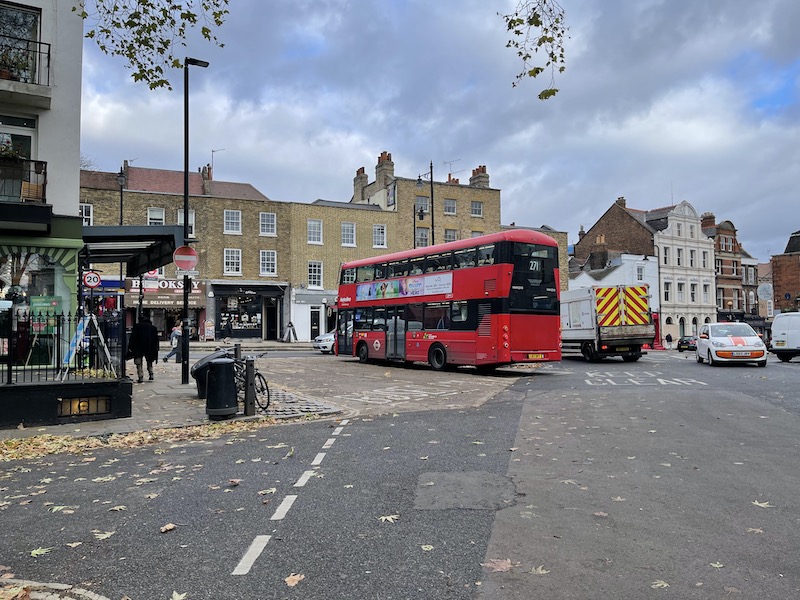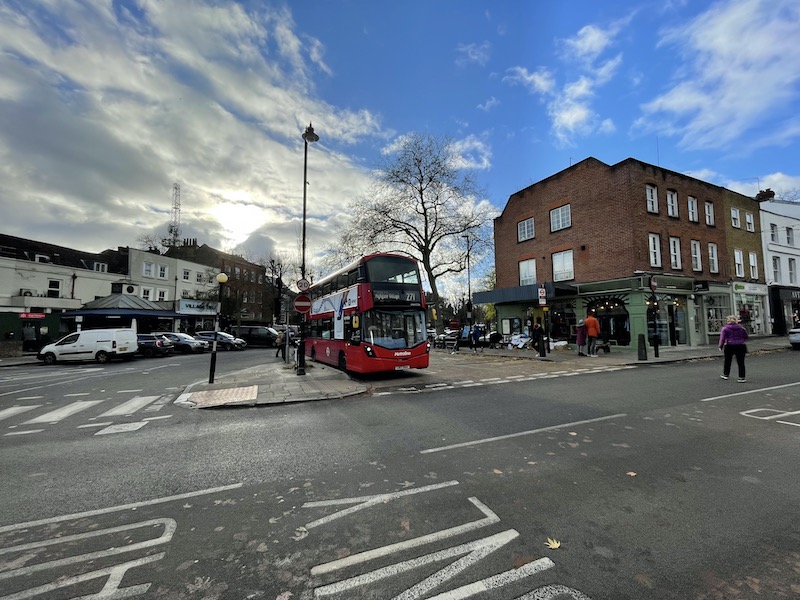Sunday 9th January 2022

Today’s the last day to submit comments in response to TfL’s consultation on the proposed withdrawal of routes 168 and 271.
Regular readers will be aware I’ve been chronicling the relentless reductions in London’s bus routes since August last year and uncharacteristically for TfL noted none of these have been subject to public consultations. As the route itself hasn’t altered, just the number of buses and how often they run, it’s fair game for a regulated authority to act as though it were a deregulated regime and just do it.



TfL’s latest slimming down proposals will reduce frequencies along New Kent Road, Waterloo Road and Kingsway (involving routes 1, 168 and 188) and New North Road, Holloway Road and Highgate Hill (involving routes 21 and 271 as well as routes 143 and 263) but as they’re simpler to achieve on these corridors served by multiple routes by withdrawing a complete route rather than changing timetables on a myriad of other routes it’s necessary to ask everyone what they think of the idea.
TfL has therefore gone into full consultation mode instead of simply going ahead and reducing the frequencies of routes that otherwise don’t change. So although it’s pretty certain it’s a done deal, we still get to have our say.
The consultations for both schemes opened on 22nd November and documents explain the rationale with the aid of ‘before’ and ‘after’ maps although it would have been easier to have had the maps combined into one so a visual representation of the changes could be better assimilated.
Here’s TfL’s rationale for reducing the bus service ….
London is constantly changing, and we therefore continuously review the bus network to ensure services reflect changing demand and deliver value for money. In central and inner London, increased rail capacity and improved active travel options continue to change the way people travel. Demand on many central and inner London routes was declining prior to the coronavirus pandemic, and while the pandemic’s long-term impacts on demand are currently unclear, ridership is not expected to fully return to pre-pandemic levels in the near future.
We are therefore reviewing services in central and inner London to ensure they reflect current and projected usage. We want to make sure our bus services match up with passenger demand whilst ensuring key links across the city are maintained. To do this, some structural changes to routes are required.
Our proposals would help to make the bus network simpler, more efficient and well connected, as well as ensuring resources are better invested and aligned to passenger demand. They would help reduce operating costs – helping ensure that we can continue to invest in the services that customers rely on. Londoners would continue to experience an accessible, regular and reliable bus service.
It has all the hallmarks of what happens in a regulated bus network to make the finances add up. You reduce frequencies of the routes with the most potential to attract passengers on busy corridors (as in … “make the bus network more efficient” and “reduce operating costs”) to keep lesser used routes in low density residential areas going (as in …. “ensure we can continue to invest in the services customers rely on”).
As bus operators found in the 1970s and early 1980s it’s a recipe for continued decline in passengers, but let’s not allow history get in the way of ideology.

As to these proposals although it’s likely route number 168 will disappear, no section of its current route will be unserved by bus routes (the short withdrawn stretch to Old Kent Road Tesco at the southern end is covered by seven or eight other routes). It could also be the case that route number 1 will be ditched, as that’s involved in the rationalisation too, but it would be too dramatic a step to lose that iconic number so the betting is route 1 will be used for the newly extended amalgam of both its current route from Canada Water to the Bricklayers Arms, where it joins route 168, and the section of that route continuing on to Hampstead Heath. On the consultation map this new route is denoted as “NEW”.


The proposals also envisage the northern terminus of route 188 switching from Russell Square to the Tottenham Court Road stand vacated by route 1, as that’ll enable the saving of a couple of buses or so from that route too.

Sadly route number 271 is unlikely to be so lucky, even though it’s got its own iconic status in London Bus Route Heritage circles being the Capital’s longest standing route still operating as it’s always done since being established in July 1960 when trolleybus route 611 was converted to Routemaster buses.

Both its termini are also iconic with Moorgate’s Finsbury Square a well loved trolleybus terminal point while the turning circle in Highgate Village is just simply wonderful.

It’s always been one of my favourite London terminal points, probably from those heady days of XA/XF and RML trials in the mid 1960s on the route.

There’s a gorgeous original London Transport display case still in situ although it’s currently morphed into decoration for the living room wall of a local Highgate Village resident.


On my recent visit towards the end of last year I noticed the turning circle seemed much harder to negotiate with modern buses and would be quite tricky to fit two buses on to the stand.

Another nice thing about it is, unlike at many terminal points in London, including Finsbury Square, you are actually allowed to board a bus on the stand rather than drivers having an exclusive waiting area for themselves with passengers banned.


So I will greatly miss route 271 but can’t argue with the rationale for its withdrawal. As the maps show all its route will be covered by other buses not least a diversion in Hoxton for route 21 to head north to Holloway Nags Head instead of Newington Green.

Although this means a frequency cut on that section of that route it’s ably served by route 141 which will I’m sure provide enough capacity while the section of New North Road only served by route 271 will have the 21 instead as far as its new terminus in Holloway.

North of Archway routes 143 and 263 will swap over roads served in North of Archway which will maintain links from the Holloway area through to Highgate Village currently provided by route 271.
There are also proposals for a school route 620 and, bearing in mind route 271 is a 24 hour operation, a new route N271 for night time journeys running as far north as North Finchley and south to Moorgate Finsbury Square, so there will still be some link with that terminus of old and that route number.
If you want to let TfL know your views, here’s the link but the consultation closes tonight.

Roger French
Blogging timetable: 0600 TThSSu.
Next blog: Tuesday 11th January 2022: Braintree’s new bus interchange

Brilliant analysis as always thank you Roger & to think in LRT days the 188 actually terminated in Euston Bus Station
LikeLiked by 1 person
Thanks Richard.
LikeLike
The stand at Highgate Village has been under threat for just the reason pointed out . . . indeed, the route specification only permits one bus on stand at any one time.
Route N271 was cut back from Liverpool Street to Finsbury Square during the rebuilding of the Bus Station, and hasn’t returned before now, as traffic delays along the route (yes, even at night!!!) have made the route nearly impossible to run on time; especially now that large parts of the route have a 20MPH limit applying.
Any improvements in running time were stymied by the inflexibility of the timetable specification, and that any improvements would increase the PVR from 2 to 3.
Even slightly widening from every 30 minutes to every 35 minutes between 23:30 and 03:00 would’ve helped . . . and at that frequency passengers will consult the bus stop times before travelling.
LikeLiked by 1 person
Am I simple ? With regard to routes 271/21/143/263. Would it not have been easier to “push” the 21 up to Highgate Village rather than only as far as “Nag`s Head ? This would have covered the 271 all the way from Moorgate, and left the 143 and 263 as they currently are. Simples.
LikeLike
Great review, and thanks for the reminder about sending comments to TfL. I agree with your views on reductions in London; I just hope that, where passengers will in future have to change bus, TfL will make sure that it is easy (e.g. not having to walk too far or cross too many roads) and that way-finding signs between stops for different routes are as clear as e.g. on the Underground.
Is anyone else frustrated by the small size of standard UK bus stop information panels? I’d suggest that font-size and everything else be increased at least four times. Where there’s a bus shelter there would be plenty of space, and where there isn’t – well, maybe there should be, if there’s a lot of information to display. It would show that the service provider is proud of what they are selling; it would give confidence to passengers and would-be passengers (maybe irrationally, people do tend to believe more what they read in large print); it would enable all of us – not just people with poor eyesight – to read timetables on a dark night when the glass is covered in condensation.
LikeLike
I think I read somewhere that some buildings had to be demolished to create the trolleybus turning area at Highgate Village, there being no nearby alternative, The trams of course had simply reversed in the High Street. I doubt that the buildings will be rebuilt, it’s more likely the area will become a ‘pocket park’. Regarding busboybrian’s suggestion, that wouldn’t solve the stand problem at Highgate Village.
LikeLike
After observing many, many almost empty buses in Central London these past six months, I am surprised it had taken TfL so long to reduce services thus far. I think we also forget, that like Manchester’s tram network, London’s Overground services and other improvements have made a massive impact on the bus network, particularly north of the River Thames. From what I have seen, outer London bus services, particularly those in the South East corner which are far from the London Underground, loadings remain reasonable. Any reductions in services are regrettable, but you cannot go on running almost empty buses however they are paid for. If the passengers return, so can the service levels.
And yes, East Grinstead’s Daimer Fleetlines looked superb sitting at the iconic Highgate Village terminus!
LikeLike
Actually the 271 goes back a lot longer It was originally a tram route
LikeLike
The W7 bus – formerly 212 and 111 – has run consistently between Finsbury Park station and Muswell Hill since 1914. W7 since 1969.
LikeLike
Would it be more sensible to extend the 263 to Morrgate and terminate the 21 at Highbury Barn
LikeLike
Really great article and analysis, as always.
It’s madness to continue to run buses at the same frequency as before Covid, so TfL should be applauded for cutting back, although they really need to be more ruthless. The same applies for the railways.
Coming from the private enterprise manufacturing sector, I’m always surprised of the attitude of those in public transport, where there’s no priority to match income and expenses. Instead there’s expectation on always being subsidised and bailed out by the government. Reading Mr French’s reports is an eye-opener, finding out about overpriced new stations, subsidised electric bus fleets and wasted public funds paying for ‘dial or click a ride’ bus services: who first had that bright idea?
LikeLiked by 1 person